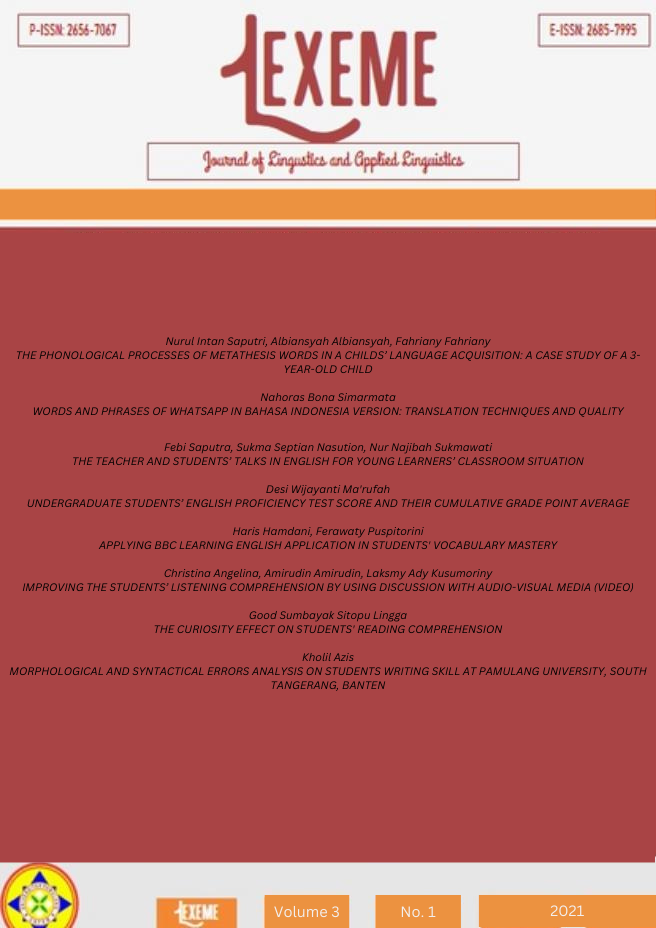IMPROVING THE STUDENTS’ LISTENING COMPREHENSION BY USING DISCUSSION WITH AUDIO-VISUAL MEDIA (VIDEO)
DOI:
https://doi.org/10.32493/ljlal.v3i1.15657Keywords:
audio visual media, listening skill, videoAbstract
This research focuses on the use of audio-visual media (video) to improve the students' listening skill for the seventh-grade students of SMP PGRI Curug in the academic year of 2019/2020. Aim of this study is to find out whether the use of audio-visual media (video) can improve the students‟ listening skill and how far the improvement in students listening skill by using audio-visual media (video). The method of this research is action research. The technique of data analysis is qualitative research. Each cycle comprises planning, acting, observation, and reflecting. The researcher stated that there is an improvement of students‟ listening skill using audio-visual media (video). It can be seen from the number of students who pass the passing grade (KKM) in cycle I and cycle II. The passing grade is 70. The result of a listening test in a pre- cycle without using video got an average score of 64,80 or 33 % of students to get a good score or the passing grade (KKM). In the cycle, I, the result of the listening test using video, got an average score of 71,07. or 66 % of students get a good score or the passing grade (KKM). The students were easier to listen to. Although they still found it difficult to focus while watching a video. The result of the listening test got better in cycle II. The students were more understanding in doing their activity using video. In this cycle, they got an average score of 76,93 or 100 % of students to get a good score or the passing grade (KKM).
References
Amelia. (2017). Teaching listening using song lyrics through audio-lingual method (an experimental research of seventh grade students of junior high school SMP Al- Amanah). (Unpublished Undergraduate’s Thesis). Universitas Pamulang.
Brown, H. D. (2004). Language assessment: Principle and classroom practices. (New York: Longman.
Craven, M. (2004). Listening extra. Cambridge: Cambridge University Press.
Duffy-Lever, J. (2003). Teaching and learning with technology. USA: Pearson Education Inc.
Goh, C. C. M. (2002). Teaching listening in the language classroom. SEAMEO Regional Language Centre.
Harmer, J. (2004). The practice of English language teaching: Third edition completely revised and updated. England: Longman.
Janusik, B. (2010). Listening pedagogy: Where do we go from here?. In Andrew, D. W. (Ed.), Listening and human communication in 21st century (pp. 193-224). London: Blackwell Publishing.
Lancara. (2009). Teaching listening through watching English movie. (Unpublished Undergraduate’s Thesis). Universitas Pamulang.
Linse, C., & Nunan, D. (2005). Practical English language teaching: Young learners. New York: McGraw-Hill.
Meskill, C. (1996). Listening skills development through multimedia. Journal of Educational Multimedia and Hypermedia, 5(2), 179-201.
Susilowati, A. (2013). Improving the tenth-grade students’ listening skills using videos at SMAN 4 Yogyakarta in the academic year of 2012/2013. (Unpublished Undergraduate’s Thesis). Universitas Negeri Yogyakarta.







